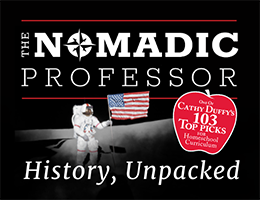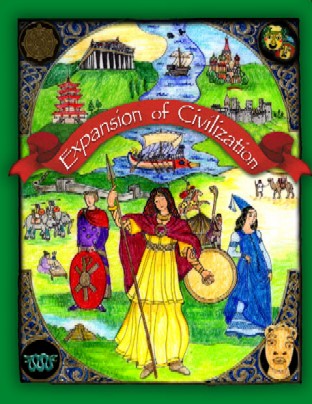TRISMS (Time Related Integrated Studies for Mastering Skills) differs from most unit study programs because it is research-based rather than tied to a particular spine or core book, and it is designed for fifth grade through high school. The five TRISMS courses are:
History’s Masterminds
Discovering the Ancient World
Expansion of Civilization
Rise of Nations
Age of Revolution
History’s Masterminds might be used for students as young as fifth-grade level, but it should then be used as a two-year course. Its target audience is grades seven and eight. It covers the beginning of recorded history through 2012 A.D.
Discovering the Ancient World is a one-year course for grade eight or nine. It goes back to the beginning, covering pre-history through 500 B.C. Expansion of Civilization and Rise of Nations are each one-year courses for high school level. The first covers 500 B.C. through A.D. 1500, while the second slightly overlaps, beginning at A.D. 1440 and continuing through 1860.
Age of Revolution might be used as either a one- or two-year high school course. It covers 1850 through 2005. Those concerned about coverage of U.S. history will be pleased to note that Age of Revolution focuses primarily on the United States. However, U.S. history does not receive thorough coverage in TRISMS, so you might need to supplement or use another course simply to meet requirements.
“Time Related,” represented by the T and R in the TRISMS curriculum acronym, refers to the chronological approach of the study, which covers the history of the world from early civilizations to the present. I appreciate the chronological approach for upper levels, since most students still need to learn how events and ideas interact and influence each other over time. Biblical history plays a major role in Discovering the Ancient World, but biblical and religious history is also incorporated throughout the other volumes to a lesser extent. The other four volumes can fairly easily be adapted by those who prefer a more secular approach since the Bible and religion coverage is not a major focus.
“Integrated” refers to the integration of language arts, writing, history, science, geography, art, music, architecture, rhetoric, philosophy, economics, and culture studies. Writing is taught with a Teaching Writing: Structure and Style component that you can use or not as you wish.
High school students using the program earn full course credits for history/social studies and language arts. Science studies are historical in nature and are adequate for junior high students if they complete all assignments at more than a superficial level. High school students might receive a credit for either a survey or general science course in all but the Rise of Nations and Age of Revolution volumes, but they will need to complete separate lab courses for other science credits.
Students might also earn partial or full credits for electives such as bible history, music or art history, critical thinking, philosophy, government, economics, or historical architecture. Any of the last four volumes might be supplemented to develop a credit for economics, but the last three volumes would likely be best for this purpose. (Suggestions for expanding the study of economics are included in each volume.) TRISMS provides detailed information on appropriate subject credits that might be given for each course.
As I mentioned, TRISMS is a research-based curriculum. For each time period or region studied, students are given questionnaire forms, each with a standard list of questions (the same questions for each time period). Each time period or unit also includes a unique worksheet that addresses that particular civilization or time period. Students use reference works, biographies, historical fiction, and nonfiction books as their primary sources of learning rather than textbooks. Similar questionnaires are used for scientists, inventions, and explorers in History’s Masterminds and for art history, music history, and architecture in the other volumes. Age of Revolution uniquely presents U.S. and world history side by side and includes questionnaires for Major Powers, Wars, Nobel Prize Winners, and U.S. Presidents. While the questionnaires focus on specific content, other student assignments require interviews, book reports, map work, drawing, research, and lengthy compositions. On top of these assignments, students will tackle one or more in-depth projects each year.
TRISMS presents an interesting combination of both structured and discovery learning—especially through research. The questionnaires at first glance seem highly structured, but these are really recording and accountability devices for study that might be accomplished in a number of ways. TRISMS recommends resources but doesn’t restrict users to those resources. Students need not do every assignment in TRISMS, but parents or teachers can select more or fewer structured learning activities depending upon the learning style and needs of each student.
As students move up through the levels, there is definitely a gradual shift in TRISMS that reflects a classical approach to education. The first level leans more toward informational learning (grammar stage). Other volumes shift toward more challenging thinking and philosophical ideas (dialectic stage) as well as research and writing (rhetoric stage).
Students at all levels read and respond to literature, especially as they develop composition skills through activities centered around the literature. Literature readings draw from writings of the civilizations or time periods studied. Many actual readings—especially poetry and excerpts from classical literature—are included in the curriculum, although you still need to borrow or buy other resource books. (TRISMS offers resource packages at discounted prices that should appeal to those who would rather not search out their own resources.)
Other language arts activities include developing composition skills and vocabulary. Grammar receives some attention in the first volume, but not in the others. You might use another resource if a student needs additional work on grammar.
For composition, language arts assignments incorporate lessons and activities from Teaching Writing: Structure and Style (TWSS). This makes TRISMS a great tool for applying lessons learned through TWSS, but literature and writing assignments can be completed without using it. TWSS does not normally come with TRISMS but is available from TRISMS as a stand-alone product or in a discounted resource package.
Math is not included in any of the volumes, although some references are made to mathematical discoveries and accomplishments in history.
In each TRISMS volume, an overview of each unit is shown in chart form as a “Unit Plan.” Charts show events in chronological order, then correlate (in other columns) topics or events in art, music, architecture, science, and literature. A rhetoric column is added to Expansion of Civilization and Age of Revolution, and the science column is dropped from Rise of Nations and Age of Revolution. Vocabulary words, map details, “Compare Questions” for writing assignments, and other assignments that might be used for each unit are included in the unit plan charts. Expanded explanations of assignments follow under different subject area headings. There are 18 units per course, and it should take about two weeks to complete each unit for one-year courses.
While History's Masterminds does have daily lesson plans for middle school, the rest of the TRISMS courses do not specify daily assignments.
Student work output is to be put into one or more “coursebook” binders. The student package pages that come with each course might be divided into their unit sections within the binders to get set up. Other work such as drawings or compositions should also be inserted into the binders. Students will also be creating a timeline. You can make your own, purchase one from another publisher or purchase TRISMS’ version, It’s About Time ($10). It’s About Time is a spiral-bound 28-page book of lined pages to be used for recording timeline information. Each page is sectioned into seven different areas with double lines. This is useful for written information, but the lines really preclude using it for illustrations.
The five TRISMS courses are ultimately similar in the way they work, but they are packaged differently. One consistent item for all courses is a large packet of student worksheets, activity pages, quizzes, and tests. Permission is given to reproduce these for family members but not for a co-op or other group class. Extra packets are sold separately for $30 each for printed pages or $20 each for digital downloads.
Map Keys (with blank maps, bonus maps and map answer keys) are available for all courses except Age of Revolution as downloads ($24.95 each).
The other components for each course vary. History’s Masterminds has four parts: a teacher’s manual and answer key, student assignment book, student pack/test packet, and Map Keys. Discovering the Ancient World, Expansion of Civilization, and Rise of Nations each have a student manual that includes all of the literature selections plus a teacher key, a student pack (questionnaires, maps, and worksheets), and a test packet. Age of Revolution has four volumes: two teacher's manuals, two student books, and two student packs that include tests. (You can purchase Age of Revolution one semester at a time if you wish.)
Age of Revolution is about double the size of the other courses, including about twice as many work and activity sheets per unit. Each unit is also more extensive than in the other volumes. Some of this is because of the inclusion of more (and lengthier) literary works. Some space is taken up by studies of movies—at least one each of a historical movie and a literature-based movie per unit. Students also work on a 12- to 15-page research paper, producing it as a series of three research essays that they work on throughout the year. The paper’s theme will be drawn from one of seven different types of “revolutions” that are studied: revolutions in economics, the arts, science, society, race, politics, and faith. This course, even more than the others, raises many philosophical and belief questions for students to consider, but it avoids promoting particular viewpoints.
Each TRISMS course except for Age of Revolution includes instructions for adaptation for a wider span of grade levels, including using the high school volumes with students as young as sixth-grade level. Age of Revolution definitely targets a high school audience with a heavy emphasis on the humanities, rhetoric, and higher-level thinking skills, so it would be more difficult than the other courses to adapt.
In addition to the TRISMS components for each course, there are a number of other essential resources: an atlas, globe, world map, encyclopedia, thesaurus, dictionary, one or more three-ring notebooks, colored pencils, and coil-bound index cards (for vocabulary words). Students also need library and internet access.
Supplements
Catholic families might want to supplement any volume of TRISMS with An Overview of Catholic History by Katie Torrey (PDF for $14.95). This specialized guide adds questions, topics, timeline activities, and recommended resources for an expanded study of Catholic history.
Another TRISMS publication, Reading through the Ages ($29 print or $19.95 download), serves as a supplement alongside all of the TRISMS volumes or can be used on its own. It contains lists of briefly-annotated recommended reading books which are arranged chronologically. A key is used to indicate reading level, page count, and whether the book is historical fiction or biography.
Summary
Parents or teachers need to put some effort into planning and overseeing student work, but TRISMS offers a stimulating alternative to traditional curriculum, especially for less-than-enthusiastic students. (Bear in mind that students with poor writing skills might have trouble with the many written assignments in the program.) TRISMS might be a comfortable form of unit study for parents shifting from traditional textbook and workbook type curricula to unit studies since it has the built-in structure and accountability tools that are lacking in many other unit studies. It might also appeal to parents who like unit studies but worry about accountability for high school students. College prep students who have completed TRISMS courses should be well prepared with the skills necessary for college-level work, and they should have excellent documentation of their work in TRISMS. In addition, the curriculum is fully accredited by the North Atlantic Regional High School diploma program (www.narhs.org).











